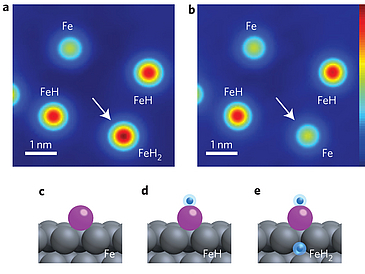A. A. Khajetoorians, M. Valentyuk, M. Steinbrecher, T. Schlenk, A. Shick, J. Kolorenc, A. I. Lichtenstein, T. O. Wehling, R. Wiesendanger and J. Wiebe.
Nature Nanotechnology (2015) 10, 958–964.
The recently proposed concept of a Hund's metal—a metal in which electron correlations are driven by Hund's rule coupling—can be used to explain the exotic magnetic and electronic behaviour of strongly correlated electron systems of multi-orbital metallic materials. Tuning the abundance of parameters that determine these materials is, however, experimentally challenging. Here, we show that the basic constituent of a Hund's metal—a Hund's impurity—can be realized using a single iron atom adsorbed on a platinum surface, a system that comprises a magnetic moment in the presence of strong charge fluctuations. The magnetic properties can be controlled by using the tip of a scanning tunnelling microscope to change the binding site and degree of hydrogenation of the 3d transition-metal atom. We are able to experimentally explore a regime of four almost degenerate energy scales (Zeeman energy, temperature, Kondo temperature and magnetic anisotropy) and probe the magnetic excitations with the microscope tip. The regime of our Hund's impurity can be tuned from an emergent magnetic moment to a multi-orbital Kondo state, and the system could be used to test predictions of advanced many-body theories for non-Fermi liquids in quantum magnets or unconventional superconductors.


